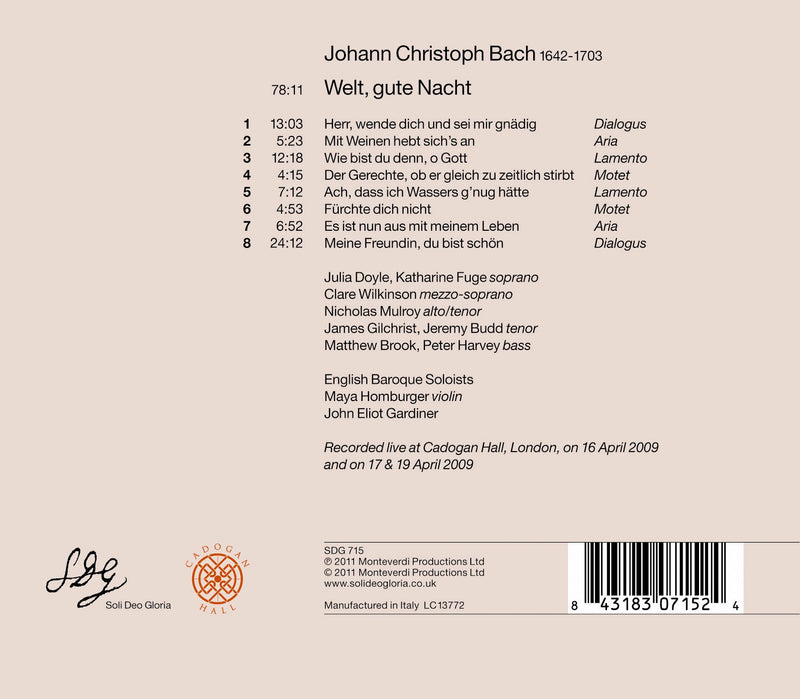Sir John Eliot Gardiner’s live Brahms symphony cycle reaches its penultimate stage and once again he illuminates the symphony in question with interesting and relevant choral music. Previous issues in the series have included some vocal music by contemporaries or past masters that Brahms admired but on this occasion Brahms has sole billing. All the music has its own value and interest but it’s especially pertinent to preface the symphony with
Gesang der Parzen, the piece that bears the immediately previous opus number in the Brahms catalogue. It’s also an unusual step to follow the symphony with a choral item - which I presume was also done in the live concerts - but I find the lovely
Nänie complements the symphony very successfully and its inclusion sustains the calm mood with which the symphony comes to an end. In the notes, which once again take the form of an extremely enlightening discussion between Sir John and the composer, Hugh Wood, Gardiner makes it clear that he constructed a deliberate sequence in which the Third Symphony was surrounded by
Gesang der Parzen and
Nänie. It’s a typically stimulating, not to say audacious juxtaposition and I find that it works well.
In these two choral works it was instructive to compare Gardiner’s versions with the fine recordings by Claudio Abbado (DG 435 791-2) made between 1989 and 1991. Of course, the performances are radically different in that Abbado uses a much larger choir and the Berlin Philharmoniker. They differ also in that, generally speaking, Abbado’s treatment of both pieces is more spacious than Gardiner’s. I’ve loved
Nänie ever since I first had the chance to sing in performances of it in 1997. As it says in the notes to this release, it’s probably the most radiant thing that Brahms ever wrote. I’m not sure that Gardiner quite conveys that radiance. It’s a fine performance, to be sure, and beautifully sung and played but, for me, Abbado, with his slightly greater sense of space, conveys the essence of the piece even more successfully. And at the marvellous moment, marked
Più sostenuto, where the choir sings in unison “Aber sie steigt aus dem Meer mit allen Töchtern des Nereus” (‘But she rises from the sea with all the daughters of Nereus’) (Track 10, 5:05 in the SDG recording) Gardiner is impressive but Abbado conveys even more nobility. When I listen to this Gardiner performance I think that
Nänie is a fine work; when I listen to Abbado I know it’s a
wonderful work.
When it comes to
Gesang der Parzen, however, it’s a rather different story - though again one is comparing two fine accounts. Here Gardiner’s lean muscularity is right on the money and he delivers a performance that is dramatic and often fiery. The vivid colourings generated by his fine orchestra are much to be savoured here. And when the final stanza of Goethe’s words - beginning at “So sangen die Parzen” - is reached (track 5, 9:32) Gardiner and his forces realise quite marvellously the spectral nature of the music. Abbado, by contrast, is softer and more mysterious in this passage. Both performances are very impressive in their different ways but I’m very excited by Gardiner’s reading.
The other choral works, whilst less substantial, have much to offer. In particular
Es tönt ein voller Harfenklang is quite lovely. And what an inspired accompaniment Brahms provides, choosing the imaginative combination of a harp - suggested by the text, of course - and a solo horn. The performance is beautiful. Though none of the music on this disc is by other composers, one of Brahms’s admired forebears gets a significant look-in with
Einförmig ist der Liebe Gram in which Brahms takes thematic material from ‘Der Leiermann’, the concluding song from Schubert’s
Winterreise and weaves it into an ingenious and very effective six-part canon for unaccompanied female choir.
I think the performance of the Third Symphony may be quite controversial and I would encourage listeners who may be startled by it to persevere. It was quite a culture shock to come to this performance so soon after
appraising Sir Simon Rattle’s new cycle of the Brahms symphonies. However, beyond noting in passing that Sir Simon’s performance of this symphony lasts for 39:12 compared with Sir John’s 33:30, I haven’t made any comparisons whatsoever. The conceptions of each performance, to say nothing of the respective forces involved, would render any such comparisons meaningless and invidious; both have their own validity. As with the previous issues in this series, the most valid comparison of which I can think is with the performance contained in the 1997 Telarc cycle by Sir Charles Mackerras, which, incidentally, takes 35:34.
It’s helpful, I think, to read the notes prior to listening - something that I failed to do until after my first hearing of the symphony! - for then one gets a good idea of how Gardiner views the music. He sees the Third as “a symphony of protest and acquiescence”, believing that in it “Brahms, at the age of fifty, shakes his fist at the march of time and then resigns himself to its inevitability.” That’s a most interesting stance and I’ve no doubt that it explains in particular Gardiner’s way with the first movement. I’d describe his account of that movement as bracing and invigorating - it’s certainly one of the fleetest I’ve ever heard. It’s interesting to note that Gardiner comments that he believes that fairly consistent adherence to one basic tempo for much of the movement is helpful in helping the music cohere “and towards giving it a light-footed grace.” So, having launched the movement, Gardiner doesn’t relax the basic pulse very much at all, whereas Mackerras, whose core speed is not that much different, is more inclined to observe “traditional” rubato. Gardiner’s performance has a bit more edge and quite a lot more drive. I’ll admit I found his approach a bit disconcerting at first but, with repeated listening, I’ve come to relish the directness.
He gives a more “conventional” account of II in terms of pacing and in this movement the fresh, unvarnished colours of his orchestra, the woodwinds in particular, pay dividends. Overall, Gardiner is relaxed and nicely poised in this movement and Mackerras is not dissimilar in his view.
There’s a nice lyrical flow in III. Gardiner allows his players to phrase expressively but never at the risk of heaviness. As in the previous movements, the clarity of texture is admirable. Some may be surprised by the way in which Gardiner moves the music forward in the brief passage from 1:55 to 2:19 and again when this material is reprised. Mackerras adopts much more traditional pacing here.
In the finale Gardiner achieves a real eruption of energy at 0:42 and thereafter the movement proceeds at an exhilarating pace until around 5:45 when Brahms begins to wind the music down to its luminous, accepting conclusion. Mackerras also gives a very extrovert account of the main allegro, though his tempo is not quite so frenetic. However, the sound that his modern instruments produce and the less forward recording means that his reading sounds softer grained. When we reach the coda I thought at first hearing that Gardiner doesn’t relax sufficiently and doesn’t find enough repose in the music. That’s a view I’ve modified with repeated listening. Now I feel that his treatment of the coda works and, of course, it’s at one with his conception of the rest of the movement and, indeed, of the symphony as a whole. Mackerras leads a more expansive, reflective account of the coda. It’s beautifully delivered but I now wonder if it’s not just a little bit
too slow.
So Gardiner has given us a very fine Brahms Third. I suspect it may divide opinion but I would urge collectors who may find it too brisk, especially in the first movement, to suspend judgement until they’ve had a chance to listen a few times. This is a fresh, vital performance and whilst it’s certainly not the only way with the symphony, it’s a way that commands respect and which I find refreshing and exciting. And even more so than was the case with the two previous volumes in this series I’d urge collectors to listen to the disc from start to finish in the sequence that Gardiner intended and allow him to lead and stimulate your ears. The final instalment in this series, containing the Fourth Symphony, is eagerly awaited.
-- John Quinn, MusicWeb International
 {# optional: put hover video/second image here positioned absolute; inset:0 #}
{# optional: put hover video/second image here positioned absolute; inset:0 #}
 {# optional: put hover video/second image here positioned absolute; inset:0 #}
{# optional: put hover video/second image here positioned absolute; inset:0 #}
 {# optional: put hover video/second image here positioned absolute; inset:0 #}
{# optional: put hover video/second image here positioned absolute; inset:0 #}
 {# optional: put hover video/second image here positioned absolute; inset:0 #}
{# optional: put hover video/second image here positioned absolute; inset:0 #}
 {# optional: put hover video/second image here positioned absolute; inset:0 #}
On Sale
{# optional: put hover video/second image here positioned absolute; inset:0 #}
On Sale {# optional: put hover video/second image here positioned absolute; inset:0 #}
On SaleSDG
{# optional: put hover video/second image here positioned absolute; inset:0 #}
On SaleSDG {# optional: put hover video/second image here positioned absolute; inset:0 #}
{# optional: put hover video/second image here positioned absolute; inset:0 #}
 {# optional: put hover video/second image here positioned absolute; inset:0 #}
SDG
{# optional: put hover video/second image here positioned absolute; inset:0 #}
SDG {# optional: put hover video/second image here positioned absolute; inset:0 #}
On SaleSDG
{# optional: put hover video/second image here positioned absolute; inset:0 #}
On SaleSDG {# optional: put hover video/second image here positioned absolute; inset:0 #}
SDG
{# optional: put hover video/second image here positioned absolute; inset:0 #}
SDG {# optional: put hover video/second image here positioned absolute; inset:0 #}
On SaleSDG
{# optional: put hover video/second image here positioned absolute; inset:0 #}
On SaleSDG {# optional: put hover video/second image here positioned absolute; inset:0 #}
SDG
{# optional: put hover video/second image here positioned absolute; inset:0 #}
SDG {# optional: put hover video/second image here positioned absolute; inset:0 #}
SDG
{# optional: put hover video/second image here positioned absolute; inset:0 #}
SDG {# optional: put hover video/second image here positioned absolute; inset:0 #}
SDG
{# optional: put hover video/second image here positioned absolute; inset:0 #}
SDG {# optional: put hover video/second image here positioned absolute; inset:0 #}
SDG
{# optional: put hover video/second image here positioned absolute; inset:0 #}
SDG


 {# optional: put hover video/second image here positioned absolute; inset:0 #}
{# optional: put hover video/second image here positioned absolute; inset:0 #}


 {# optional: put hover video/second image here positioned absolute; inset:0 #}
{# optional: put hover video/second image here positioned absolute; inset:0 #}

 {# optional: put hover video/second image here positioned absolute; inset:0 #}
{# optional: put hover video/second image here positioned absolute; inset:0 #}

 {# optional: put hover video/second image here positioned absolute; inset:0 #}
{# optional: put hover video/second image here positioned absolute; inset:0 #}


 {# optional: put hover video/second image here positioned absolute; inset:0 #}
{# optional: put hover video/second image here positioned absolute; inset:0 #}


 {# optional: put hover video/second image here positioned absolute; inset:0 #}
{# optional: put hover video/second image here positioned absolute; inset:0 #}


 {# optional: put hover video/second image here positioned absolute; inset:0 #}
{# optional: put hover video/second image here positioned absolute; inset:0 #}

 {# optional: put hover video/second image here positioned absolute; inset:0 #}
{# optional: put hover video/second image here positioned absolute; inset:0 #}


 {# optional: put hover video/second image here positioned absolute; inset:0 #}
{# optional: put hover video/second image here positioned absolute; inset:0 #}


 {# optional: put hover video/second image here positioned absolute; inset:0 #}
{# optional: put hover video/second image here positioned absolute; inset:0 #}



 {# optional: put hover video/second image here positioned absolute; inset:0 #}
{# optional: put hover video/second image here positioned absolute; inset:0 #}


 {# optional: put hover video/second image here positioned absolute; inset:0 #}
{# optional: put hover video/second image here positioned absolute; inset:0 #}


 {# optional: put hover video/second image here positioned absolute; inset:0 #}
{# optional: put hover video/second image here positioned absolute; inset:0 #}

 {# optional: put hover video/second image here positioned absolute; inset:0 #}
{# optional: put hover video/second image here positioned absolute; inset:0 #}

 {# optional: put hover video/second image here positioned absolute; inset:0 #}
{# optional: put hover video/second image here positioned absolute; inset:0 #}